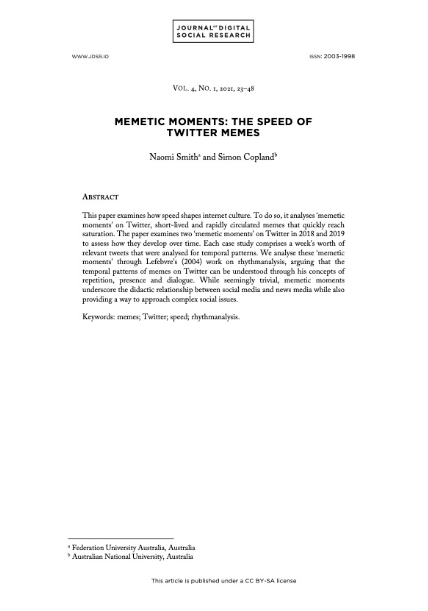Memetic Moments: The Speed of Twitter Memes
DOI:
https://doi.org/10.33621/jdsr.v4i1.95Keywords:
memes, twitter, social network analysis, speed, joy, rythmanalysisAbstract
This paper examines how speed shapes internet culture. To do so, it analyses ‘memetic moments’ on Twitter, short-lived and rapidly circulated memes that quickly reach saturation. The paper examines two ‘memetic moments’ on Twitter in 2018 and 2019 to assess how they develop over time. Each case study comprises a week’s worth of relevant tweets that were analysed for temporal patterns. We analyse these ‘memetic moments’ through Lefebvre’s (2004) work on rhythmanalysis, arguing that the temporal patterns of memes on Twitter can be understood through his concepts of repetition, presence and dialogue. While seemingly trivial, memetic moments underscore the didactic relationship between social media and news media while also providing a way to approach complex social issues.
References
Abidin C. and Kaye, B. (2021). Audio Memes, Earworms, and Templatability: The ‘Aural Turn’ Of Memes” in eds. Arkenbout, C, Jack Wilson and Daniel de Zeeuw, Critical Meme Reader: Global Mutations of the Viral Image ( pp. 58-68). Amsterdam: Institute of Network Cultures.
Ackland, R. (2013). Web social science: concepts, data and tools for social scientists in the digital age. London: SAGE.
Bapna A., and Lokhande, A. (2021).“Post-Truth Design Tactics in Memes in India: 198 Decoding Malicious Design Practices in Right-Wing Meme Factories” in eds. Arkenbout, C, Jack Wilson and Daniel de Zeeuw, Critical Meme Reader: Global Mutations of the Viral Image (pp. 198-216). Amsterdam: Institute of Network Cultures.
Beck, U. (2000). The Brave New World of Work. Cambridge: Polity Press.
Bell, C. (2018, November 16). Journalist criticised for ‘sexists’ Ocasio-Cortez tweet. BBC News. Retrieved from: https://www.bbc.com/news/blogs-trending-46233260.
Benwell, M. and Paul, K. (2019, August 6). What about the 30-50 feral hogs? Man's defence of assault weapons goes viral. The Guardian. Retrieved from: https://www.theguardian.com/us-news/2019/aug/05/feral-hogs-memes-twitter-30-50-running-into-my-yard-small-kids.
Cook, H. (2019, October 9). Facebook removing likes is good for social media. Mumbrella. Retrieved from: https://mumbrella.com.au/facebook-removing-likes-is-good-for-social-media-601557.
Dang, L., Chen, Z., Lee, J., Tsou, M.-H. & Ye, X. (2019). Simulating the spatial diffusion of memes on social media networks. International Journal of Geographical Information Science, 33(8), 1545–1568, https://doi.org/10.1080/13658816.2019.1591414
DeLuca, K. M. (2006). “The Speed of Immanent Images,” in ed. Hope, D. Visual Communication: Perception, Rhetoric, and Technology (pp. 79-90). New York, NY: Hampton Press.
De Valle, G. (2018, November 16). The real reason conservative critics love talking about Alexandria Ocasio-Cortez’s clothes, Vox. Retrieved from: https://www.vox.com/the-goods/2018/11/16/18099074/alexandria-ocasio-cortez-clothes-eddie-scarry.
Gal, N. Shifman, L. & Kampf, Z. (2016). “It Gets Better”: Internet memes and the construction of collective identity. New Media & Society, 18(8), 1698–1714, https://doi.org/10.1177/1461444814568784.
Giddens, A. (1990). The Consequences of Modernity. Cambridge: Polity Press.
Harvey, D. (1989). The Condition of Postmodernity. Oxford: Blackwell.
Hatmaker, T. (2020, October 10). Changing how retweets work, Twitter seeks to slow down election misinformation. TechCrunch. Retrieved from: https://social.techcrunch.com/2020/10/09/twitter-retweet-changes-quote-tweet-election-misinformation/.
JafariAsbagh, M., Ferrara, E., Varol, O., Menczer, F., & Flammini, A. (2014). Clustering memes in social media streams. Social Network Analysis and Mining 4(1), 237, https://doi.org/10.1007/s13278-014-0237-x.
Jenkins, E. S. (2014). ‘The Modes of Visual Rhetoric: Circulating Memes as Expressions’, Quarterly Journal of Speech, 100(4), 442–466, doi:10.1080/00335630.2014.989258.
Lash, S. (2002). Critique of Information. London: Sage.
Lears, R. (2019). Knock Down the House. Netflix.
Lefebvre, H. (2004). Rythmanalysis: Space, Time and Everyday Life. New York: Continuum.
Losse, K. (2012). The Boy Kings: A Journey into the Heart of the Social Network. New York: Simon and Schuster.
Massanari, A. (2017). #Gamergate and The Fappening: How Reddit’s algorithm, governance, and culture support toxic technocultures. New Media and Society, 19(3), 329–346, https://doi.org/10.1177/1461444815608807.
Miltner, K. (2014). “There’s no place for lulz on LOLCats”: The role of genre, gender, and group identity in the interpretation and enjoyment of an Internet meme. First Monday 19(8), https://doi.org/10.5210/fm.v19i8.5391.
Miltner, K. (2018). Internet memes. In J. Burgess A. Marwick, & T. Poell The sage handbook of social media (pp. 412-428). London: SAGE. https://www.doi.org/10.4135/9781473984066.n23
Mirani, L. (2020, June 29). No more going viral: why not apply social distancing to social media? The Guardian. Retrieved from: https://www.theguardian.com/commentisfree/2020/jun/29/social-distancing-social-media-facebook-misinformation.
Nissenbaum, A. & Shifman, L. (2017). Internet memes as contested cultural capital: The case of 4chan’s /b/ board. New Media & Society, 19(4), 483–501, https://doi.org/10.1177/1461444815609313
O’Neil, M. & Jensen M. (2020). Australian Perspectives on Misinformation. News and Media Research Centre: University of Canberra. Retrieved from: https://www.canberra.edu.au/research/faculty-research-centres/nmrc/research/australian-perspectives-on-misinformation.
Phillips, W. & Milner, R. M. (2017). The Ambivalent Internet: Mischief, Oddity, and Antagonism Online. Cambridge, UK: Polity Press.
Reply All (2019, October 10). “#149 30-50 Feral Hogs”. Gimlet Media. Retrieved from: https://gimletmedia.com/shows/reply-all/n8hw3d.
Rosenberg, E. (2018, November 16). Alexandria Ocasio-Cortez wore clothing, a journalist tweeted a photo, and the internet pounced. The Washington Post. Retrieved from: https://www.washingtonpost.com/nation/2018/11/16/eddie-scarry-tweet-about-alexandria-ocasio-cortezs-clothing-is-latest-critique-about-class/.
Salter, M. (2018). From geek masculinity to Gamergate: the technological rationality of online abuse Crime, Media, Culture, 14(2), 247–264, https://doi.org/10.1177/1741659017690893.
Segev, E., Nissenbaum, A., Stolero, N., & Shifman, L. (2015). Families and Networks of Internet Memes: The Relationship Between Cohesiveness, Uniqueness, and Quiddity Concreteness. Journal of Computer-Mediated Communication, 20(4), 417–433, https://doi.org/10.1111/jcc4.12120.
Souroush V., Roy D. & Aral, S. (2018). The Spread of True and False News Online. Science, 359(6380), 1146-1151, doi: 10.1126/science.aap9559.
Srnicek, N. (2017). Platform Capitalism. Cambridge, UK: Polity Press.
Terranova, T. (2012). Attention, economy and the brain. Culture Machine, 13, 1–19. Retrieved from: https://culturemachine.net/wp-content/uploads/2019/01/465-973-1-PB.pdf.
Tuters M., Jokubauskaité E. & Bach D. (2018). Post-truth protest: how 4chan cooked up the Pizzagate bullshit. M/C Journal, 21(3), https://doi.org/10.5204/mcj.1422.
Thrift, N. (1996). New Urban Eras and Old Technological Fears: Reconfiguring the Goodwill of Electronic Things’, Urban Studies, 33(8), 1463– 93, https://doi.org/10.1080/0042098966754.
Twint (2021). Twint Project. Retrieved from: https://github.com/twintproject/twint.
Venturini, T., Jacomy, M. & Pereira D. (2016). Visual Network Analysis. Retrieved from: http://www.tommasoventurini.it/wp/wp-content/uploads/2014/08/Venturini-Jacomy_Visual-Network-Analysis_WorkingPaper.pdf.
Venturini, T. (2019). From fake to junk news, the data politics of online virality. In D. Bigo, E. Isin and Ruppert E. (eds), Data politics: worlds, subjects, rights (pp. 123-144). London: Routledge.
Virilio, P. (2000). Open Sky. London: Verso.
Wiggins, B.E., & Bowers, G.B. (2015) Memes as genre: A structurational analysis of the memescape. New Media & Society, 17(11), 1886–1906, https://doi.org/10.1177/1461444814535194.

Downloads
Published
Issue
Section
License
Copyright (c) 2021 The Authors

This work is licensed under a Creative Commons Attribution-ShareAlike 4.0 International License.



